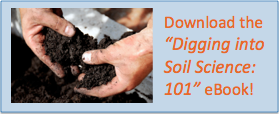The Science Behind Holganix
Is Your Soil Healthy?

Time and time again, this blog has addressed the need and importance for soil health. After all, you can’t have a beautiful turf without healthy soil. Soil is responsible for numerous functions that create a healthy turf. For example, according to Cornell University, soil retains and cycles nutrients, helps with pest and weed suppression and produces food and fiber for plants. If your soil isn’t healthy, more and more synthetic fertilizers, herbicides and pesticides are needed to counteract the negative effects of poor soil quality. But how do you know if your lawns have healthy soil?
Soil testing is always a good idea, especially for lawns that you repeatedly have problems with (usually signals poor soil quality). Soil testing typically comprises a measurement of the present nutrients including nitrogen, phosphorous, potassium, sulfur and calcium as well as a pH measurement. A good soil test will also feature a soil composition report to tell you where, in the range of sandy to clay, your customer’s soil stands in its composition. Knowing what nutrients are in the soil, its acidity and even its composition can greatly help you identify problems and solutions that will assist you in selling needed services to your customers. For example, the customer may have a heavy clay soil. Showing your customer this fact will help you promote aeration and over seeding to an otherwise stubborn client. Or perhaps the report indicated the pH level is high or low. Point this out to your client and recommend a program to adjust the pH (lime or sulfur).
If soil testing isn’t your thing, examining the soil and plants for yourself could also help shed some light on soil conditions. According to Cornell University’s Soil Health Manual, there are ten characters of healthy soil. Below is a break down of several key characteristics into easily understood chunks.
1. Sufficient depth: In other words, how deep can your plant roots grow and function? The deeper they can delve into, the better.
2. Nutrients: Are your plants receiving enough nutrients? Are they receiving too much? If your plants aren’t receiving enough nutrients, growth is hampered; however, if they receive too much, leaching can occur. Leaf coloration, pH, and moisture content can signal nutrient deficiency. It would be a good idea to become familiar with these signals.
3 Small population of plant pathogens and insect pests: Having a large population of nasty plant pathogens and insects spells trouble for your plants. However, having no pathogens means throwing the soil off balance. At Holganix, we believe an ideal ratio of good to bad microbes is 4:1. It’s important to learn the signs of plant disease and insect damage.
4. Large populations of beneficial organisms: Soil microbes are extremely important. “Healthy soil will have a high and diverse population of beneficial organisms” (Cornell University, Soil Health Manual). Beneficial microbes will produce high organic matter and good soil structure. Learn more about soil microbes here.
If you want to learn more about these characteristics, explore this link for Cornell’s Soil Health Manual.

 |
September 23, 2014
|
6:47 PM
|
September 23, 2014
|
6:47 PM
-2.jpg)
-1.jpg)
-1.jpg)
-1.jpg)
.jpg)

-2.jpg)
-1.jpg)
-1.jpg)
-1.jpg)
.jpg)






.webp)
-1%20(1).webp)
-831535-2.webp)




